Pear - an aromatic fruit with tasty juicy pulp. Each garden does not do without a pear tree.
Fruits are consumed fresh, as well as compotes, jams, marmalades and juice. The advantage of the fruit is that they are stored for a long time.
Every gardener strive to get a good harvest. But it happens that the fruits start to rot before they ripen on the tree. What are the reasons and how to save the fruits?
Table of contents
Why do pears rot and crack on tree branches?
Everyone noticed rotten pears on a tree; old selectional varieties are mainly subject to this phenomenon. Since their pedigree is directly related to the wild pear.
It so happens that on the skin of all a small speck, and inside the whole pulp is brown and very soft. This suggests the cunning of the fungus, which is ready to destroy not only the appearance, but also the taste.
Fruit rot on apples and pears:
Spores of fungus appear on the infected fruit, on which conidia form. They are carried by wind, rain and insects.
As a result, there is a complete infection of the remaining fruits. The rotting of the pear begins with the tail, and to full maturity the fruit can rot completely.
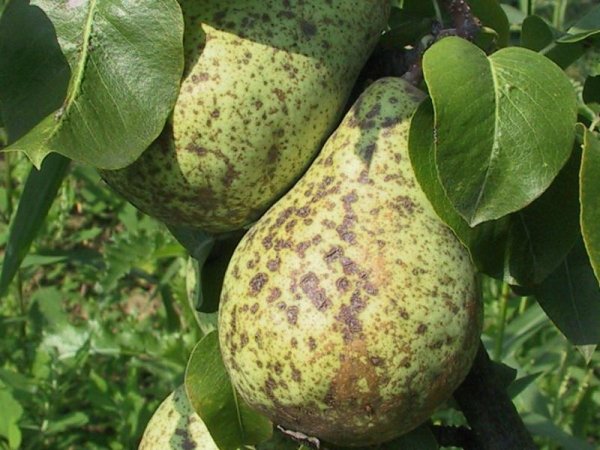
The problem must be solved fundamentally, that is, will have to remove the old tree.
There is another option save the harvest.Collect pears in immature condition. Large and firm green pears are laid out in the shade, and in a few days you can enjoy fragrant, sweet fruits.
As for the varieties of new breeding, they ripen on the tree. Stored long in a cool place. The cause of decay becomes a fungus.
The fight against the disease is necessary instant. Clean infected pears away from healthy. Do not bury infected fruits with moniliasis in the ground or stored in a compost pit.
Why? This is due to the fact that fungus spores are well tolerated by cold, so they can get in the spring to other trees. A massive defeat threatens the lack of harvest.
Monilioz on fruit trees:
Where the fruit rot is taken from the trees
The fungus moniliosis can get into the fetus through damage to the skin. Damage to the fetus is easy. Insects, hail, rain, wind can do this.
Infection is also possible. due to close contact with the infected fungus fruit. Since last year, infected fruits may remain hanging, which spread the infection to a new crop.
Crown of the tree can spread the diseasetherefore, all affected leaves, branches, fruits must be removed during sanitary pruning.
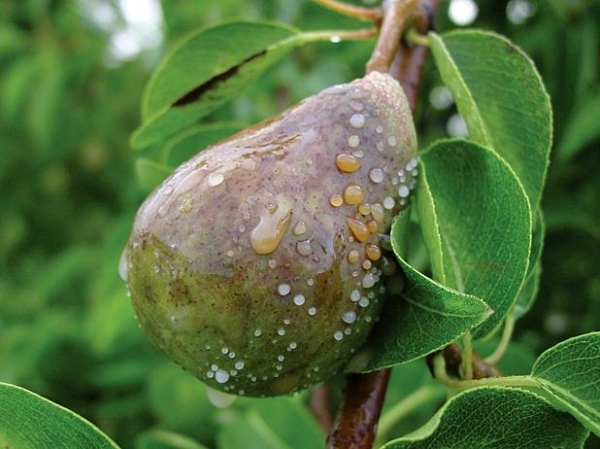
Infected fruits that are not removed after harvesting darken, dry out, and natural mummification occurs. These fruits are desirable to cut along with the branches.on which they hang.
The fungus may be located on the bark of a tree for a long time, with time this place darkens. therefore diseased branches are pruned to capture healthy wood tens of centimeters. All dried shoots pruned to a place with healthy wood.
The disease is tolerated by spores of the fungus by the wind and insects that love to feast on the flesh of a sweet fruit. Favorable conditions for the development of moniliosis is warm and high humidity.
Signs of fruit rot in the trees:
- Symptoms of fungus can begin to appear in the spring.
- Infection can occur at the time of ripening.Since during this period the skin becomes softer and spores of fungi can penetrate it. As a result, mold begins to develop, which spreads to the entire fetus.
- At the site of infection, sporulation of the fungus occurs; it looks like it has a round outline with small bright patches in the form of circles. The fungus spreads quickly, affecting not only the skin, but also the flesh.
- Infection can occur not only when transferred by insects, but also through close contact of an infected fetus.
- Infected fruits fall off in strong winds, but they can also hold tight on the stalk, with time they dry out and remain hanging on the tree. They harden, that is, mummified and become black and blue. The fungus is not afraid of the cold, so it can easily winter in fruits, branches and shoots.
- Favorable conditions for the emergence of spores of the fungus is darkness, low temperature and humid air.
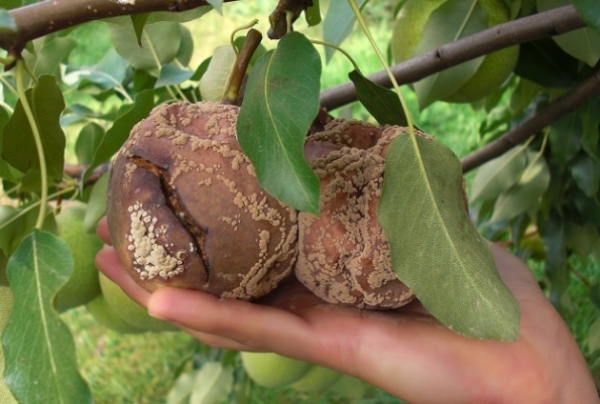
What if the fetus rots, how to deal with moniliasis?
Caring for future harvests begins in spring. As soon as the snow melts, it is necessary to inspect the tree and the area near it. Collect all last year's foliage and branches, and most importantly the fallen fruit.
If last year's fruits are hanging on the tree, they must be removed.b, as they may be infected with spores of the fungus. He loves the dense crown and dried branches that do not yield a crop.
Therefore, in order to prevent the monilioz from multiplying, it is necessary to thin the crown, cut off the dried and weak branches.
You may be interested in the following publications:
If the pear variety is prone to rot, be sure to treat wood with drugs as a preventive:
- First processing must be done in the period of swelling of the kidneys. To do this, use products containing copper. They will help protect the tree from moniliosis. As a chemical drug, you can use Bordeaux fluid.
- Second treatment drugs after pear bloom.
- During the fruiting period the procedure is carried out several times.
- Last treatment fungicidal carried out after harvest. To do this, use copper sulphate, which need to be well processed crown, trunk of pears and tree trunks.
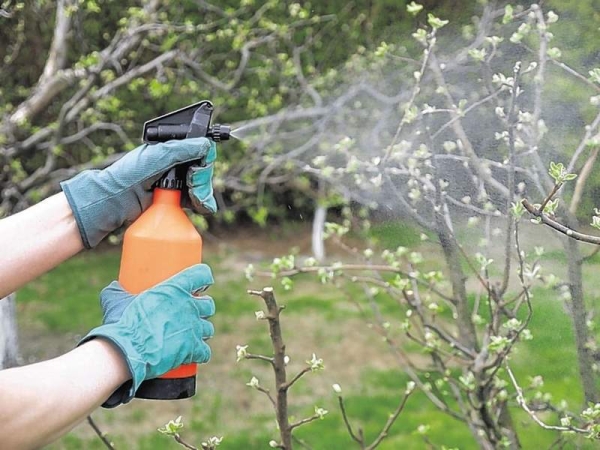
At high humidity All pear varieties must be treated with preparations to prevent the spread of the fungus.
It is advisable to use organic fungicides, such as Bordeaux liquid, copper oxychloride. Processing can be carried out during flowering and after it.
Monilioz affects only fruit, but fungal spores can be stored on foliage, crown, and ground. As soon as rotten pears are noticed on the tree, immediately remove them from the branches so that the infection does not spread further.
Collect fallen rotten fruits, as they are also a peddler of the fungus.
Prevention of fruit rot
Taking care of the tree is necessary throughout the year, but special attention must be paid in early spring:
- Pruning dried shoots at the end of winter, before bud swelling. To prune dead and broken branches, calling on the healthy part.At this time it is necessary to collect and destroy all last year’s fallen leaves remaining on the branches.
- Collect all mummified fruits., they are a danger to the new crop.
- Crown thinning is necessary so that the trees dry faster after the rain. Due to this, the chances of getting sick of monilioses against a tree are reduced several times.
- Thinning. With a good harvest, leave only large fruits.
- During harvest, remove the fruit gentlyDo not damage the branches. Before you put a pear in storage inspect each fruit. Infected pears should not remain on the tree and the ground, they must be destroyed.
- Wood processing with organic fungicides. When the buds begin to swell, it is desirable to treat the tree with Bordeaux mixture. It is necessary to process not only wood, but also pristvolnuyu territory. Processing should be after flowering fungicidal drugs that protect the fruit. The procedure is repeated several times, before the fruit ripens and after harvest.
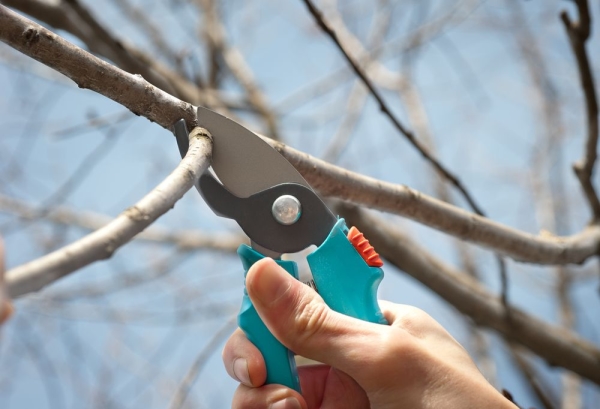
Remember that timely fight against fungus will keep the harvest. Moniliasis affects fruits with seeds and a bone, therefore at the first signs of the disease it is worthwhile to begin an active struggle with the problem.
Take care of the tree in time., and it will definitely thank you for a rich harvest.
